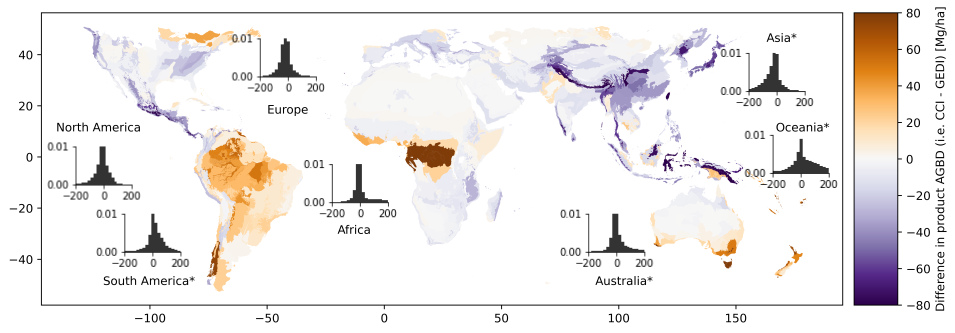Biomass refers to the living part of vegetation systems, and it plays a crucial role in Earth’s climate. Destruction of vegetation releases carbon dioxide, a greenhouse gas, to the atmosphere. At the same time, vegetation pulls carbon dioxide out of the atmosphere and stores it as biomass. Biomass changes, especially in forests, can be both a key cause of climate change as well as a way to mitigate it.
Using open data from missions and initiatives conducted by multiple space agencies is one way global biomass can be consistently and periodically assessed. Biomass-related airborne and satellite missions include NASA’s Global Ecosystem Dynamics Investigation (GEDI) and Ice, Cloud, and land Elevation Satellite-2 (ICESat-2); ESA’s Sentinel missions; the joint NASA/ESA AfriSAR airborne mission; and the upcoming ESA BIOMASS and NASA/Indian Space Research Organization Synthetic Aperture Radar (NISAR) missions. In addition, undertakings such as ESA’s Climate Change Initiative (CCI) combine a suite of satellite data and provide higher-level products, including global biomass maps.
While NASA, ESA, and other national space agencies, along with the NewSpace commercial sector, are producing a wide range of biomass maps, transparency in biomass map products, flexibility of definitions, and the assessment of their inherent uncertainties are required for these maps to be useful in national policy-related biomass reporting, which supports undertakings like the GST. Analyzing how biomass maps from multiple sources can be harmonized for global use is a research objective perfectly suited for MAAP.
“The faster the science of space-based biomass estimation advances, the greater the risk of products being disparate, and hence disregarded or incorrectly used in the policy domain, which is detrimental to any contribution to efforts towards climate change mitigation,” says Dr. Neha Hunka, assistant research professor in the Department of Geographical Sciences, University of Maryland, and principal author on the research. “MAAP is a platform that brings both transparency and collaboration between teams involved in forest biomass estimation, allowing them to work through datasets consistently and comparably, and to communicate a clearer message on forest biomass stocks.”
MAAP Overview
MAAP is an ongoing NASA and ESA effort and reflects the cooperation between the two agencies under the NASA and ESA Joint Program and Planning Group (JPPG) Joint Working Group (WG) on Ground Segment and Operations. MAAP was designed to support collaborative research, and brings together relevant data, algorithms, and computing capabilities in a common cloud environment to address the challenges of sharing and processing data from field, airborne, and satellite measurements. In keeping with NASA open data policies, all MAAP data, services, and software are available to research and applications communities, private industry, academia, and the general public.
MAAP in Action: Comparing Biomass Estimates from Satellite Data
The CEOS Biomass Map Harmonization effort, which is funded by MAAP and NASA’s Terrestrial Ecology Program, used MAAP to comparatively assess two sets of aboveground biomass density (AGBD) estimates: one set derived from NASA GEDI data and another set provided by ESA’s CCI. The objective of the work was to ensure that the biomass estimates from these two sources can potentially be used to inform subsequent cycles of GSTs.
MAAP provided direct access to the biomass maps used as well as access to some of the underlying data that went into the production of these maps. The flexible algorithm development and rapid computation provided by the platform allowed the intercomparison of the underlying methods and assumptions used in production of the maps. In addition, the platform facilitated the production of national and sub-national estimates of forest biomass in a transparent, coherent, and consistent manner. As noted by the research team, MAAP’s open-science approach has fostered the first open-dialogue and open-data collaboration between various science teams involved in forest biomass estimation.
MAAP was used to intercompare two of the latest (as of April 2023) estimates of forest biomass, generate sub-national estimates for countries with varying forest definitions and ecoregions, and subset GEDI footprint-level relative vegetation height metrics for ecoregions that needed a closer investigation—all within the same platform with access to every necessary dataset. This unique functionality allowed assessments to be conducted within days of the public release of new biomass maps.

